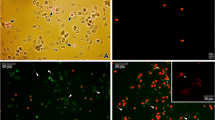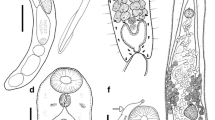Summary
Excystation ofEimeria magna required exposure to CO2 at body temperature followed by trypsin and bile. Incubation in the presence of CO2 produced marked effects on the inner layer of the oocyst wall. The evidence suggests that CO2 stimulates enzymic activity from within the oocyst rather than exerting a physico-chemical effect on the oocyst wall from the outside. Released sporozoites measured 19.65×3.33 μm. In the rabbit,E. magna undergoes at least 5 cycles of asexual schizogony before gametogony takes place. First-generation schizonts were observed at 30 hr, measured 15×11 μm and contained 4, 6, 8 or occasionally 12 merozoites; the merozoites were characterized by two very large and prominent refractile granules. As the infection progressed, schizont size and merozoite numbers became more variable; some schizonts contained 2–8 fat merozoites, many probably multinuclear, while other schizonts contained 12–100 thinner merozoites. First generation schizogony took place in the glands; all subsequent stages developed in the upper parts of the villi of the small intestine. Sexual forms have been seen as early as 96 hr, but maximum sexual activity was notes at 120–192 hr. Oocysts measured 35.87×24.05 μm. The first oocysts were passed 6–7 days after inoculation, with peak production at 8–9 days. Sporulation was optimal at 30°C; higher temperatures inhibited sporulation, and were in time lethal, while sporulation would take place normally after suppression by cold for at least 11 months. Single oocyst inoculations indicated a maximum reproductive potential of 26.15 million. Pathogenic effects were mostly mild, amounting to growth depression over days 4–7 and softening of the faeces; occasionally diarrhoea and/or death occurred.
Similar content being viewed by others
References
Danforth, H. D., Hammond, D. M.: Stages of merogony in multinucleate merozoites ofEimeria magne Pérard, 1925, J. Protozool.19, 454–457 (1972)
Hibbert, L. E., Hammond, D. M.: Effects of temperature on in vitro excystation of variousEimeria species. Exp. Parasit.23, 161–170 (1968).
Jolley, W. R., Nyberg, P. A.: Formation of carbon dioxide-cysteine complex in the incubation fluid used for excystingEimeria species in vitro. Proc. helminth. Soc. Wash.41, 259–260 (1974)
Kheysin, Y. M., Cheissin, E. M.: Coccidiosis of rabbits. III. The developmental cycle ofEimeria magna [in Russian], Uch. Zap. Len. God. Ped. Inst. Gertsena30, 65–91 (1940)
Kheysin, Y. M. (Kheisin, E. M.): Cytological investigation of the life cycle of rabbit coccidia. 2.Eimeria magna Pérard, 1924 (1960). English translation in: Problems of Cytology and Protistology Israel Program for Scientific Translation, Jerusalem 1961
Kheysin, Y. M.: Life cycles of coccidia of domestic animals (1967). English translation by F. K. Plous, ed by. K. S. Todd. Baltimore: University Park Press 1972.
Pellérdy, L., Dürr, U.: Zum endogenen Entwicklungszyklus vonEimeria stiedai (Clindemann, 1865) Kissalt und Hartmann, 1907. Acta vet. Acad. Sci. hung.20, 227–244 (1970)
Pérard, C.: Recherches sur les coccidies et les coccidioses du lapin. III. Étude de la multiplication endogène. (Identification d'une 3e espèce du coccidie du lapin:Eimeria magna n.sp.). Ann. Inst. Pasteur39, 952–961 (1925).
Rutherford, R. L.: The life cycle of four intestinal coccidia of the domestic rabbit. J. Parasit.29, 10–32 (1943)
Ryley, J. F.: Cytochemistry, physiology and biochemistry. In: D. M. Hammond, ed., The coccidia, pp. 145–181. Baltimore: University Park Press 1973
Speer, C. A., Hammond, D. M.: Development of first-and second-generation schizonts ofEimeria magna from rabbits in cell cultures. Z. Parasitenk.37, 336–353 (1971)
Speer, C. A., Hammond, D. M., Elsner, Y. Y.: Further asexual development ofEimeria magna merozoites in cell cultures. J. Parasit.59, 613–623 (1973)
Wang, C. C., Stotish, R. L.: Pancreatic chymotrypsin as the essential enzyme for excystation ofEimeria tenella. J. Parasit.61, 923–927 (1975).
Author information
Authors and Affiliations
Rights and permissions
About this article
Cite this article
Ryley, J.F., Robinson, T.R. Life cycle studies withEimeria magna Pérard, 1925. Z. F. Parasitenkunde 50, 257–275 (1976). https://doi.org/10.1007/BF02462971
Received:
Issue Date:
DOI: https://doi.org/10.1007/BF02462971




